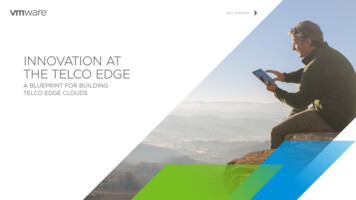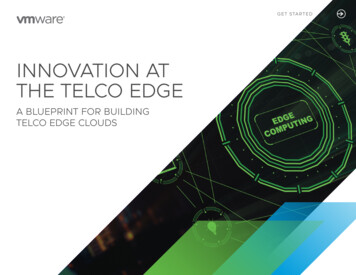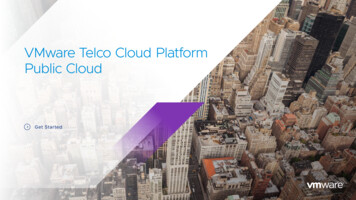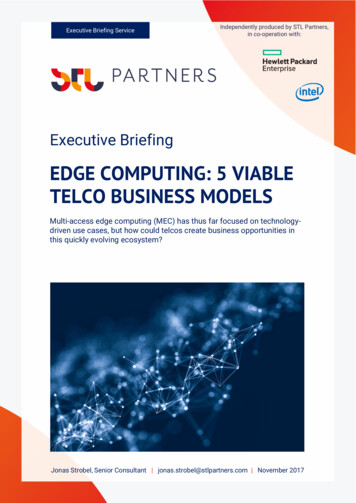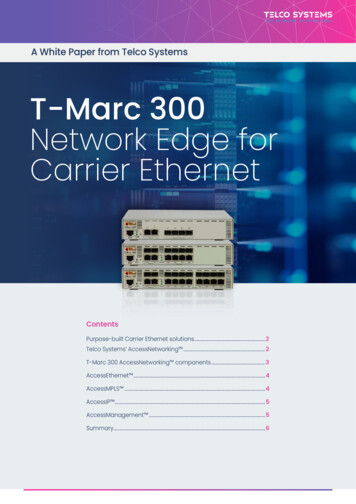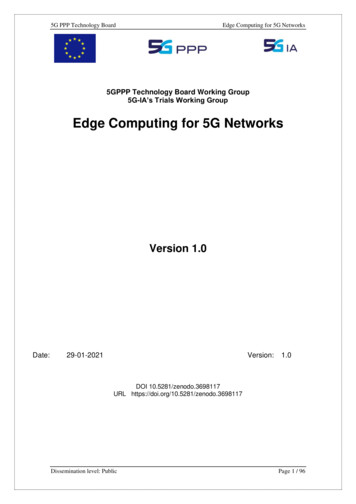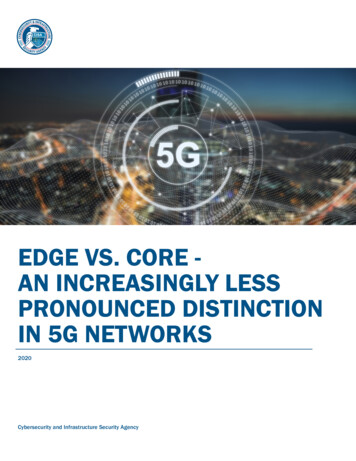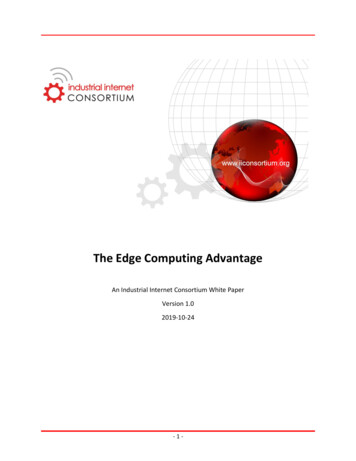
Transcription
Executive Briefing ServiceIn co-operation with:Executive BriefingEDGE COMPUTING: THETELCO BUSINESS MODELSMulti-access edge computing (MEC) has thus far focused on technologydriven use cases, but how could telcos create business opportunities inthis quickly evolving ecosystem?Jonas Strobel, Senior Consultant jonas.strobel@stlpartners.com October 2017
EDGE COMPUTING: THE TELCO BUSINESS MODELS OCTOBER 2017Table of ContentsIntroduction . 4The emerging edge computing ecosystem . 5Telcos’ MEC opportunity . 5Hyperscale cloud providers are an added complication for telcos . 6How should telcos position themselves? . 75 telco business models for MEC . 8Business model 1: Dedicated edge hosting . 9Business model 2: Edge IaaS/PaaS/NaaS . 11Business model 3: Systems integration . 13Business model 4: B2B2X solutions . 15Business model 5: End-to-end consumer retail applications . 17Mapping use cases to business models . 19Some business models will require a long-term view on the investment . 20Which business models are right for which operator and which operator division? . 22Conclusion . 24 STL PartnersEXECUTIVE BRIEFING2
EDGE COMPUTING: THE TELCO BUSINESS MODELS OCTOBER 2017Table of FiguresFigure 1: Defining MEC . 4Figure 2: MEC benefits . 5Figure 3: Microsoft’s new mantra – “Intelligent Cloud, Intelligent Edge” . 7Figure 4: STL Partners has identified 5 telco business models for MEC . 8Figure 5: The dedicated edge hosting value chain. 9Figure 6: Quantified example – Dedicated edge hosting. 10Figure 7: The Edge IaaS/PaaS/NaaS value chain . 11Figure 8: Quantified example – Edge IaaS/PaaS/NaaS. 12Figure 9: The SI value chain . 13Figure 10: Quantified example – Systems integration . 14Figure 11: The B2B2X solutions value chain . 15Figure 12: Quantified example – B2B2x solutions . 16Figure 13: Graphical representation of the end-to-end consumer retail applications business model. 17Figure 14: Quantified example – End-to-end consumer retail applications . 18Figure 15: Mapping MEC business models to possible use cases . 19Figure 16: High 3-year IRR correlates with low terminal value . 20Figure 17: Telcos need patience for edge-enabled consumer applications to become profitable (breakeven only in year 5) . 21Figure 18: The characteristics and skills required of the MEC operator change as we move along thebusiness models . 22 STL PartnersEXECUTIVE BRIEFING3
EDGE COMPUTING: THE TELCO BUSINESS MODELS OCTOBER 2017IntroductionThe idea behind Multi-Access Edge Computing (MEC) is to push compute and storage capabilities outto the edge of the telco’s network. By that, workloads and applications are closer to telco’s customers,enhancing experiences and enabling new services and offers. As we have discussed in a recent report,there is much excitement within telcos around this concept: MEC enables a plethora of vertical and horizontal use cases (e.g. leveraging low-latency implyingsignificant commercial opportunities. This is critical as the whole industry is trying to uncovernew, exclusive sources of revenue. MEC fits in with telcos’ 5G and SDN/NFV deployments, which will run certain parts of thevirtualised network distributed at the edge. In turn, MEC is dependent on the capabilities of avirtualised network to orchestrate distributed compute.Figure 1: Defining MECSource: STL PartnersHowever, despite the excitement around the potentially transformative impact of MEC on telcos,viable commercial models that leverage MEC are still unclear and undefined. As an addedcomplication, a diverse ecosystem around the idea of edge computing is emerging – of which telcos’MEC is only one part.From this, the following key questions emerge: Which business models will allow telcos to realise the various MEC use cases in a commerciallyviable way? What are the right MEC business models for which telco? What is needed for success? What are the challenges? STL PartnersEXECUTIVE BRIEFING4
EDGE COMPUTING: THE TELCO BUSINESS MODELS OCTOBER 2017The emerging edge computing ecosystemTelcos’ MEC opportunityMEC is being discussed in a variety of use case areas. These use cases on the one hand implyadvancements for existing applications such as content/application delivery or caching by bringingthese closer to the user in a geographically distributed way. On the other hand, MEC is also seen asthe key enabler for emerging scenarios, such as: Industry 4.0 automation Connected/autonomous vehicle functions AR/VR gaming Drone controlDeployed through MEC, such use case scenarios can benefit from MEC-specific features such as lowlatency, network awareness, or optimal allocation of resources. Therefore, MEC will yield benefits forboth customers and the operator itself (see Figure 2 in detail).Figure 2: MEC benefitsSource: STL PartnersHence, MEC offers the opportunity for telcos to: Improve their network operations to achieve efficiencies and cost savings STL PartnersEXECUTIVE BRIEFING5
EDGE COMPUTING: THE TELCO BUSINESS MODELS OCTOBER 2017 Differentiate their own service offerings through MEC capabilities Enable others to make use of distributed compute capabilitiesTo reap these opportunities, telcos and vendors have been trying to coordinate and integrate theirefforts, most notably through the ETSI Industry Specification Group for MEC (founded in 2014). Whileinitially the group’s work was focused on features like RAN-awareness in the context of mobile edgecomputing, there has been a reorientation to also encompass fixed-network edge computing (hence,multi-access edge computing). A first package of APIs has been released in July 2017 to facilitateinteroperability of MEC deployments.In another move towards interoperability, the ETSI group has recently signed a memorandum ofunderstanding with the OpenFog Consortium, an organisation which promotes the similar concept offog computing (a concept driven by several vendors, which is less focused than MEC on telcos’network access as part of the overall architecture). At first, both parties want to focus on standardisingAPIs to make it “easier for developers to create common architectures, unify management strategies,and write a single application software modules that run on both OpenFog and MEC architectures”.Hyperscale cloud providers are an added complication fortelcosRecently, it has become evident that the edge must not be understood as a concept that is purelyrelated to the telco network. In particular, hyperscale cloud providers such as Amazon Web Services(AWS) or Microsoft Azure have been very clear on their ambition to complement their centralised cloudservices with more distributed capabilities.In a move to “edge-enable” its existing AWS IoT Platform, Amazon launched AWS Greengrass in late2016. With AWS Greengrass, IoT applications can be run both in the centralised cloud and locally onan IoT device or gateway. AWS Greengrass utilises the same programming model as AWS’ cloud,however the capabilities at the edge are restricted to more lightweight functions (such as “serverless”compute models through AWS Lambda). Large parts of an IoT application might still run in the cloud,while there is also application logic deployed locally which performs certain analytical or controlfunctions. In such a model, roundtrip latency and bandwidth cost can be reduced by processing IoTdata locally and not sending all information back to the cloud.While Microsoft’s Azure IoT Edge provides similar capabilities as AWS Greengrass, the company haseven gone further recently: with the launch of Azure Stack, customers are now able to run the full Azurecloud environment not only in Microsoft’s centralised cloud but also on-premise on their own baremetal. This enables enterprises to make use of hybrid cloud environments in which their own premisesrepresents the edge with all the potential benefits that come with localised compute (low latency,compliance etc.).Both Amazon and Microsoft’s moves are facilitated by several trends which shift the economics infavour of more local and distributed compute and storage at the customer edge (e.g. gateways or STL PartnersEXECUTIVE BRIEFING6
EDGE COMPUTING: THE TELCO BUSINESS MODELS OCTOBER 2017servers on-premise) or even the device edge (e.g. IoT devices performing parts of the overallapplication logic themselves). These trends include: The proliferation of IoT applications which create masses of data that do not need to beprocessed centrally. Chip technologies which make it possible to perform computational tasks economically on verysmall space – both for low-performance applications (e.g. through SoCs on mass IoT devices)as well as high-performance applications (e.g. through modern GPUs for AI-dependent use casessuch as autonomous cars). Advanced cloud platforms which now facilitate distributed compute models through capabilitiessuch as hybrid cloud computing (e.g. Azure Stack) or serverless computing (e.g. AWS Lambda).Figure 3 shows how Microsoft as a centralised cloud provider now incorporates the “intelligent”edge (which can be telecoms-agnostic) into their overall cloud vision statement.Figure 3: Microsoft’s new mantra – “Intelligent Cloud, Intelligent Edge”Source: MicrosoftHow should telcos position themselves?STL Partners expects that, by extending their cloud capabilities to the customer edge and/or thedevice edge, the hyperscale cloud providers will play a strong role in the emerging edge computingmarket. This represents a significant complication for telcos because these cloud providers will beable to deliver on certain MEC promises without necessarily relying on telco/network-specificdistributed compute capabilities.How should telcos position themselves in this situation? While telcos are rightly trying to come upwith common standards and frameworks for MEC, we believe that telcos should not wait for these tomature before trying to tap into emerging commercial opportunities. With strong competition looming, STL PartnersEXECUTIVE BRIEFING7
EDGE COMPUTING: THE TELCO BUSINESS MODELS OCTOBER 2017they should explore what could be viable business models to support the many potential MEC usecases. The next section will provide a starting point for exactly that and present 5 telco business modeltypes for MEC.5 telco business models for MECIn the following section, we discuss five potential telco-centric business models for MEC, each ofwhich can support a variety of use cases:1. Dedicated edge hosting2. Edge IaaS/PaaS/NaaS3. Systems integration4. B2B2x solutions5. End-to-end consumer retail applicationsThese involve both business models in which the telco acts as an enabler of MEC services for others,as well as business models that imply an end-to-end role for telcos (see Figure 4).Figure 4: STL Partners has identified 5 telco business models for MECSource: STL PartnersFor each business model, we will: Provide a detailed description Represent the value chain graphically Model a quantified, example 3-year scenario. STL PartnersEXECUTIVE BRIEFING8
EDGE COMPUTING: THE TELCO BUSINESS MODELS OCTOBER 2017Business model 1: Dedicated edge hostingIn this first business model, the telco sits relatively low down the MEC value chain taking the role asan enabler of edge computing, rather than a provider. Here, the telco delivers and manages edgelocated (bare-metal) compute/storage resources, which are pre-installed and connected to the telconetwork. The customer/partner would run its software, which could be for example a virtual contentdelivery network (CDN) or a distributed cloud stack, on top of the telco’s edge-enabled dedicatedhardware resources. From the partner’s perspective, they would have the flexibility of being able to runtheir MEC-enabled software across multiple telecoms operators to achieve optimal coverage and beable to gain value from the use of network-aware APIs to enrich their offering.As described in Figure 5, customers for this model could include public cloud (IaaS) providers, suchas Microsoft Azure and AWS, looking to expand the coverage of their edge compute service. Otherscould be SaaS providers, local enterprises or governments and CDN providers. Similarly today, telcostypically offer colocation services to third-party CDN providers whose hardware is installed at thetelco’s (central) site; this means that the CDN’s capabilities are integrated with the telco’s networkcapabilities/data only to a limited degree. In dedicated edge hosting, running the CDN software on topof existing telco edge-based hardware will allow to also leverage data and insights from the networkto further improve capabilities and performance of the CDN.Figure 5: The dedicated edge hosting value chainSource: STL PartnersFor the operator, this business model is relatively low-risk; it relies on mostly success-based capexwith minimum commitment. The telco would only invest in its infrastructure to provide this to partnersif there was a customer established. Once set up, each order creates a revenue stream per site fromset-up fees, hosting fees and additional capabilities (e.g. APIs, value-added maintenance andmonitoring). STL PartnersEXECUTIVE BRIEFING9
EDGE COMPUTING: THE TELCO BUSINESS MODELS OCTOBER 2017This is modelled in Figure 6 as a scenario in which the telco provides dedicated edge hosting to apublic cloud provider. The results of this quantified example indicate a relatively high internal rate ofreturn (IRR) after three years. However, the telco most likely would have to enter another investmentcycle to replace some of the existing hardware; hence, the terminal value of the investment after threeyears is limited.Figure 6: Quantified example – Dedicated edge hostingSource: STL Partners STL PartnersEXECUTIVE BRIEFING10
EDGE COMPUTING: THE TELCO BUSINESS MODELS OCTOBER 2017Business model 2: Edge IaaS/PaaS/NaaSThe telco in this business model operates in a similar manner to a cloud provider, providing customersdistributed compute and storage capabilities, a platform for developing applications on the edgeinfrastructure and network services, as well as APIs and virtual network functions (VNFs) in an ‘as-aservice’ manner through a cloud portal as the customer interface.Customers would be those looking to deploy applications on the MEC infrastructure and make use ofthe benefits of the MEC platform capabilities (see Figure 7); for example, IoT application providerswho want to optimise applications so that they can analyse the data from devices to trigger actionsquickly. Other potential customers include start-ups, large enterprises, systems integrators, CDNproviders, content owners and other cloud providers.In practice, a customer would specify the location of the nodes across the telco’s MEC infrastructureand capabilities required and pay for resources (e.g. virtual machines) according to use over time.Figure 7: The Edge IaaS/PaaS/NaaS value chainSource: STL PartnersCompared to the dedicated edge hosting business model above, there is higher risk here for the telco,as it needs to invest in MEC coverage and deploying the edge infrastructure (servers, site equipment,etc.) up front before a revenue stream is established.In Figure 8, this is reflected in high one-time costs involved in rolling out MEC across large parts of thenetwork, and to develop the service. Consequently, the IRR after 3 years is comparatively lower thanfor example in dedicated edge computing. However, this business model can potentially scale to muchlarger turnover and after three years the service would have a relatively high terminal value –assuming sufficient adoption among developers. STL PartnersEXECUTIVE BRIEFING11
EDGE COMPUTING: THE TELCO BUSINESS MODELS OCTOBER 2017Figure 8: Quantified example – Edge IaaS/PaaS/NaaSSource: STL Partners STL PartnersEXECUTIVE BRIEFING12
EDGE COMPUTING: THE TELCO BUSINESS MODELS OCTOBER 2017Business model 3: Systems integrationThe systems integration (SI) MEC business model will likely build on an existing SI business within atelco, offering custom turn-key solutions for enterprise customers with specific requirements, whichare (partially) met by MEC functionality. As seen in Figure 9, MEC functionality is likely to be one ofmany components that are aggregated through the SI project; other components may includehardware and devices, other telco (not MEC-specific) capabilities, as well as third-party partnercapabilities.For example, a government or local council might invest in a MEC solution for their smart city project,which would require deployment of the MEC infrastructure and any necessary hardware (sensors,actuators and devices), integration of different networks and systems and orchestrating thedevelopment of the smart city solutions and applications. Many benefits of MEC are applicable forsmart city use cases: security, network resilience and low latency (for real-time applications).Figure 9: The SI value chainSource: STL Partners analysisIn terms of the revenue model from these potential customers (likely governments or enterprises), thebill looks much the same as a standard SI project – usually broken down according to the level ofeffort and resources required for each phase of the project (capturing requirements, plan/design,implementation, support etc.). Specific items the customer will pay for will vary by project, includingthe amount of MEC infrastructure that would need to be deployed.From a telco perspective, this business model has some reduced risks, as the MEC infrastructuredeployed may be explicitly for the customer (i.e. confined to the premises of the customer, for examplea manufacturing plant), therefore it does not require significant investment from the telco without anindication of returns on investment. STL PartnersEXECUTIVE BRIEFING13
EDGE COMPUTING: THE TELCO BUSINESS MODELS OCTOBER 2017As with many SI projects, partners are an important part of the offering – from MEC-specific hardware,equipment and software suppliers for servers, operating systems, platforms and applications, tospecialist (vertical) project partners. The telco brings value as an SI to orchestrate this ecosystem ofdifferent players through their direct channel and provide a reliable, “turn-key” implementation ofsolutions enabled by MEC.The quantified example in Figure 10 shows that the telco will recover the biggest part of its coststhrough the plan and build fees during the actual project. The profitability drivers are then fees forongoing managed services and additional feature requests which had not been planned.Figure 10: Quantified example – Systems integrationSource: STL Partners STL PartnersEXECUTIVE BRIEFING14
EDGE COMPUTING: THE TELCO BUSINESS MODELS OCTOBER 2017Business model 4: B2B2X solutionsTelcos have an opportunity to create MEC-enabled business solutions for government, enterprise orSME customers. As with existing B2B solutions, these may be for the customer’s internal purposes,such as to improve existing processes, or may contribute to an end-customer offering (B2B2X). Ingeneral, these solutions will be close to ‘off-the-shelf’ and will be less bespoke, thus requiringsignificantly less integration work, compared to SI projects.A potential solution is indicated in Figure 11, whereby the operator can provide a service for largeevents with significant network congestion, such as sports stadiums or music concerts, to enhancethe attendees’ experience by using MEC to provide an immersive video experience, offering a varietyof live video streams from different viewpoints. Event organisers can either monetise this and offer itas an additional paid service for attendees, or bundle it in with ticket prices to enhance the customerexperience. Another example for this business model is CCTV video surveillance. Transmitting all thevideo feeds to the cloud would be uneconomical, however if the footage could be analysed at the edge,only events deemed as important would trigger a notification to the relevant emergency services andsend the associated feeds to the cloud.In order to provide these types of solutions, telcos would need to partner with solution technologyvendors, to provide specific components and application, as well as MEC suppliers for hardware andsoftware parts. In addition, the telco may not solely sell directly to its customers, but may also partnerwith specialised resellers who are vertically-aligned for certain enterprise solutions.Figure 11: The B2B2X solutions value chainSource: STL Partners analysisThe risks associated with this business model are mainly due to the upfront service development andthe uncertain take-up of the solution by enterprise customers. This is also modelled in the quantified STL PartnersEXECUTIVE BRIEFING15
EDGE COMPUTING: THE TELCO BUSINESS MODELS OCTOBER 2017example in Figure 12 which shows that with sufficient adoption, a B2B2x solution (based on recurringfees) might yield significant return and a medium (and potentially high) terminal value as it is a servicewhich can be offered beyond this 3-year horizon.Figure 12: Quantified example – B2B2x solutionsSource: STL Partners STL PartnersEXECUTIVE BRIEFING16
EDGE COMPUTING: THE TELCO BUSINESS MODELS OCTOBER 2017Business model 5: End-to-end consumer retail applicationsThe last business model is ‘end-to-end consumer retail applications’. Here, the operator is playing highup the value chain, acting as a digital service provider for consumer applications. As with B2B2Xsolutions, telcos would likely need to partner with others to provide these solutions, whether it be MECsuppliers, application technology vendors or channel partners.MEC-enabled solutions in this category will leverage the benefits of MEC, namely low latency, highthroughput and context awareness, to provide consumers with innovative applications. These couldinclude Internet of Things (IoT), augmented reality (AR) or virtual reality (VR) applications that requirevideo transmission in real-time.Figure 13: Graphical representation of the end-to-end consumer retail applicationsbusiness modelSource: STL Partners analysisSome operators, such as BT, are already considering extending their existing entertainment service byadding VR to their premium offering to enhance the user experience and differentiate their proposition.Alternatively, operators could offer these services as paid add-ons to their existing services, forexample pay-per-view sporting events broadcast in VR.Such a scenario is also modelled in Figure 14. The quantified example shows that significantinvestment is needed to augment an existing content offering with MEC capabilities, e.g. for VR livesports. In the model, a break-even is only reached in the 5th year of the service, indicating significantrisks (but potentially high revenue) is associated with this end-to-end business model. Note that wehave not modelled other positive effects, e.g. on churn, which might be significant. STL PartnersEXECUTIVE BRIEFING17
EDGE COMPUTING: THE TELCO BUSINESS MODELS OCTOBER 2017Figure 14: Quantified example – End-to-end consumer retail applicationsSource: STL Partners STL PartnersEXECUTIVE BRIEFING18
EDGE COMPUTING: THE TELCO BUSINESS MODELS OCTOBER 2017Mapping use cases to business modelsGiven this broad menu of options (both in terms of use cases and business models for MEC), it iscritical for telcos to choose the right business models for the respective application. Figure 15 mapsthe above business models to possible use cases.We find that enabler business models tend to be suitable for use cases in which: Coverage (geographical, population) is required and application providers therefore need to workwith several MEC providers There might already be an existing application by a third-party (potentially hosted in thecentralised cloud) and e.g. edge IaaS is used to enrich/complement that application Net neutrality rules are relevant and telcos need to open up capabilities to third-partiesWhereas end-to-end provider business models are ideal for use cases in which: Mission criticality plays a key role and telcos need to provide a SLA-level performance/latency Compliance or privacy need to be guaranteed by a single end-to-end providerFigure 15: Mapping MEC business models to possible use casesSource: STL Partners STL PartnersEXECUTIVE BRIEFING19
EDGE COMPUTING: THE TELCO BUSINESS MODELS OCTOBER 2017Some business models will require a long-term view on theinvestmentThe quantified models have shown that a higher rate of return after 3 years is typically associated witha lower terminal value of the investment (see Figure 16).Figure 16: High 3-year IRR correlates with low terminal valueSource: STL PartnersFigure 16 shows, at least from this three-year outlook, that there are several business models whichcan be delivered with considerable profitability (namely “Dedicated edge hosting”, “B2B2x solutions”,“Systems integration”). However, these tend to be associated with a lower terminal value after thisthree-year period and a rather limited turnover/scalability overall. Put simply, they are not “cash cows”.In contrast, business models such as “End-to-end consumer retails applications” and “EdgeIaaS/NaaS/PaaS” will exhibit a higher terminal value and potential scale after the modelled three-yearperiod. However, the profitability of these business models will be still relatively limited at this point,which means telcos need to adopt a longer-term view on their investment. Figure 17 illustrates this. STL PartnersEXECUTIVE BRIEFING20
EDGE COMPUTING: THE TELCO BUSINESS MODELS OCTOBER 2017Figure 17: Telcos need patience for edge-enabled consumer applications to becomeprofitable (break-even only in year 5)Source: STL PartnersFigure 17 shows how the VR-enabled content offering (as an “End-to-end consumer application”) onlybreaks even in the fifth year. However, with growing adoption the business model then delivers anattractive margin and turnover. A telco therefore might find high value in such a business model, butonly if it is prepared to view it as a long-term investment with an associated risk of failure. STL PartnersEXECUTIVE BRIEFING21
EDGE COMPUTING: THE TELCO BUSINESS MODELS OCTOBER 2017Which business models are right for whichoperator and which operator division?Adoption of the business models outlined above is not a case of picking just the one with the mostfavourable business case. In many cases, benefits are uncertain. It is also clear that none of thesuggested business models is a cash-cow, and none individually will justify the upfront investment inrolling out MEC technology to the entire network. Operators looking to build value from MEC musttherefore endeavour to build propositions in more than one area, where synergy will help drive
cloud environment not only in Microsoft's centralised cloud but also on-premise on their own bare metal. This enables enterprises to make use of hybrid cloud environments in which their own premises represents the edge with all the potential benefits that come with localised compute (low latency, compliance etc.).


